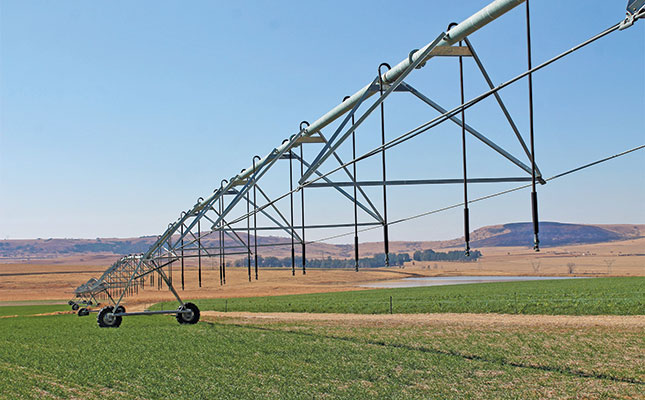
Irrigated wheat: Conservation farming improves water usage and yield
Egon Zunckel and his sons, Tyson and Carl, have been implementing conservation agriculture practices, especially no-till, on their farm’s commercial mixed grains operation since 1996.
Yet they continue researching and experimenting with ways to improve on the delicate balancing act of increasing crop yields profitably while using natural resources, such as water, ever more sustainably.
The Zunckels’ 2 150ha farm, Rustenburg, lies 15km north-west of Bergville in KwaZulu-Natal. The family produces irrigated winter wheat on about 120ha in rotation with both irrigated and dryland summer crops, typically comprising two-thirds yellow maize and one-third soya bean.
South Africa’s largest wheat-producing region, the Western Cape, receives the bulk
of its annual rainfall in autumn and winter, the growing season. By contrast, most of Rustenburg’s 50-year average annual rainfall of 850mm falls in spring and summer. This makes it essential to irrigate winter wheat crops strategically.
Zunckel says that before they introduced no-till, the farm’s predominantly Avalon-type arable soils had been prone to capping, poor moisture infiltration, and high water run-off and associated soil erosion.
Collectively, these problems were a major contributor to sub-optimal production across all of the family’s commodity crops. However, after only 10 years of no-till, in combination with covering soil surfaces with living or dead crop residue, the family were able to double the average level of beneficial soil carbon from approximately 1,4% to 3%.
This, according to Zunckel, is similar to the average soil carbon level of virgin soils in the Bergville area. Rustenburg’s average soil organic matter level is approximately 6%.
Multi-species cover crops
To further enhance soil health, the Zunckels began planting multi-species cover crops between harvesting and planting the commercial crops.
The summer cover crop mix comprises black oats, white oats, cowpeas, babala grass and Japanese radish, while the winter mix consists of white oats, black oats, Japanese radish, turnips, stooling rye and grazing vetch.
In addition to their direct benefits, the cover crops are grazed by the family’s 300-head breeding cow Bonsmara-type and Bovelder-type commercial beef herd.
The cattle’s dung, urine, saliva and hoof action also improve the soil, and the Zunckels generate additional farm income from the beef.
“We’re increasing the organic and clay colloids, which enhances the soil’s water and nutrient retention characteristics. In effect, we’re creating a bigger ‘bucket’ under the soil surface that can capture and retain more water from rain and supplementary irrigation. It’s especially important to retain as much late summer and autumn rainfall as possible so that this is available for the following winter wheat crop,” explains Zunckel.
On your marks. Irrigate. Grow!
Planting takes place from the last week of May into the first week of June. The preceding commercial crop is always leguminous soya bean, which not only fixes atmospheric nitrogen in the soil, but is harvested earlier than maize to ensure a suitable wheat planting date.
The Zunckels favour medium- to long-season wheat cultivars that are likely to flower and come into ear after their farm’s last average frost date of 16 September. These cultivars are currently Pannar 3497, Sensako SST 867, and Sensako SST 8135.
According to Zunckel, experience has taught them that 15mm of irrigation two to three days before planting provides the wheat seed with a moisture bank to kick-start and maintain even germination. This irrigation is applied using the farm’s centre-pivot systems, which range in coverage from 18ha to 50ha.
“The residue of our commercial and cover crops promotes irrigation water penetration and retention in the soil. But it must be allowed to dry off before wheat planting starts. This enables the cutting discs on the seed drill to penetrate the residue during planting without the problem of the residue hair-pinning under the discs. The wheat has to be planted 10mm to 15mm deep into the soil itself, not into the layer of decomposing plant residue on the soil surface.”
The family’s Case IH Precision Disk 500T air drill has a 12,2m planting swathe, so is difficult to turn in a tight space. But its precision technology allows the implement to be calibrated to plant wheat seed at, for example, 80kg/ha under each centre-pivot and then to change automatically to 40kg/ ha on the unirrigated land margins. Planting the margins makes it easier to turn the machine. The wheat on these dryland margins is used primarily as a cover crop.
Immediately after planting, the Zunckels apply supplementary irrigation to keep the soil profile sufficiently moist to a depth of 10cm to enhance the seedlings’ root development and early growth.
The exact volumes required for this irrigation are calculated by using results from a wireless soil moisture probe in each wheat land, together with climate information generated by privately owned digital weather stations.
Double-checking technology
“As helpful as these technologies are, they never replace our boots-on-the-field observations. We use a soil auger regularly to sample various random spots in each wheat field,” says Zunckel.
He adds that he has also learned how to use sight and touch to obtain a fairly accurate impression of soil moisture levels. If he smears a handful of soil onto his fingers
and it sticks, the soil is close to saturation.
If a ball of soil, made by first squeezing a handful of loose soil (not decomposing crop residue) in the fist, can be bounced gently in the palm of the hand without easily breaking, this indicates that the soil has good moisture content. If the ball breaks soon during bouncing, the soil is dry.
“We also use data from three or four weather forecasting sources at the same
time to schedule our wheat irrigation so as to avoid hot or berg wind conditions as much as possible.
“Irrigating in a berg wind in our area can result in a loss of as much as 40% of the applied water. It’s important to plan, so that we minimise having to apply emergency irrigation under such conditions,” Zunckel says.
Maximising water-use efficiency
The farm’s centre-pivots have been designed to apply sufficient irrigation within the windows between expected berg wind conditions, and to do so efficiently.
While more conventional centre-pivots apply 4mm to 5mm of water a day, the Zunckels’ system can apply between 7,5mm and 16mm a day.
The combination of conservation agriculture practices on the farm means that the water
from this higher volume and more rapid irrigation does not run off the soil surface to be wasted and cause erosion.
To further enhance water-use efficiencies on the winter wheat lands, the Zunckels have fitted wobbler- and spinner-type irrigation nozzles on the centre-pivots.
These nozzles produce water droplets that are suitably sized to resist most wind drift but, at the same time, are evenly distributed across the application area of the soil.
Yet another method of improving water- use efficiency is to space the nozzles 2,5m apart along the centre-pivot towers, and allow them to hang approximately 2m above the soil surface. Each nozzle is also slightly offset from its immediate neighbours to add to water distribution and infiltration.
“It’s important to have a qualified irrigation engineer design a system to suit a particular land’s soil characteristics and to maximise long-term energy-use efficiency,” says Zunckel.
combating weeds
Weeds can present serious competition for soil moisture, and the family works hard to overcome this problem on their winter wheat croplands. Before planting they analyse records for any weed challenges, such as from fleabane (Conyza spp) and Senecio vulgaris in the preceding soya bean crop.
If these are evident, they spray a pre-plant herbicide application comprising a combination of Roundup (between 1,5ℓ/ ha and 2,5ℓ/ ha) and 2,4-D (300ml/ha to 500ml/ ha).
These herbicides are selected as they have no residual effects in the soil that could negatively affect the soon-to-be-planted wheat crop.
If, after planting, the wheat germinates evenly and grows well enough to create a canopy to shade out any further weeds, they will not apply further herbicides.
If, however, weeds remain a problem, they consult their local Farmers Agri-Care agrochemicals expert to select appropriate products and calculate the required application rates.
Avoiding having to play catch-up
“We aim to keep our field capacity, which is the amount of water the soil can hold, at 50% to 80%. We leave some available capacity to avoid saturating the soil, as this would result in damaging, anaerobic conditions.
At the same time, we’re careful not to allow the groundwater level to deplete too much, because this would require us to apply an emergency irrigation to catch up again to the needs of the wheat,” explains Zunckel.
The crop’s water demands are not constant. From its tillering stage, demand increases exponentially to peak at around the flowering to grain-fill stages.
The effectiveness of the Zunckels’ approach is shown in the farm’s records. In 2016, during the drought, their dams and natural groundwater levels were worryingly low, and the family did not expect a good yield.
They planted seed at a rate of 80kg/ ha, the wheat received 257mm of water (of which 95mm were from natural precipitation), and they finally harvested a crop of 5,4t/ ha. This was substantially above the 3,76t/ ha national average (including dryland wheat) reported for 2016 by South Africa’s Crop Estimates Committee.
In 2019, which was a relatively normal rainfall year for Rustenburg, the Zunckels planted their winter wheat at 110kg/ha of seed, the crop received 506mm of water, and they achieved a yield of 8,2t/ ha.
Email Egon Zunckel at office@zunckelfarms.co.za
Source: farmersweekly.co.za
